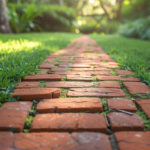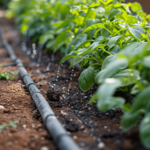Creating a stunning waterfall feature in your outdoor space can add a touch of elegance and tranquility. With the right location, materials, and design, you can transform your backyard into a serene oasis. This article will guide you through the essential steps of creating a waterfall feature, including choosing the perfect location, gathering necessary materials, planning the design and layout, building the foundation and water reservoir, installing the water pump and plumbing, and adding finishing touches for a beautiful and low-maintenance addition to your landscape.
Choosing the Perfect Location
When selecting the ideal location for a waterfall feature, it is crucial to consider various quantifiable factors such as the available space, water source, and optimal viewing angles. The first consideration is the available space. It is important to ensure that the chosen location can accommodate the size and scale of the waterfall feature. Additionally, the proximity to a water source is essential for easy maintenance and sustainability. A nearby water source will make it easier to maintain the water flow and prevent any issues with supply. Lastly, optimal viewing angles should be considered to enhance the overall aesthetics of the waterfall feature. Strategic placement of the waterfall within the landscape will ensure that it can be enjoyed from multiple vantage points. Taking these factors into account will help create a visually appealing and functional waterfall feature that integrates well with the surrounding landscape.
Gathering the Necessary Materials
In order to create a successful waterfall feature, it is crucial to gather all the necessary materials. This includes referring to a required supplies checklist to ensure nothing is missed. Additionally, selecting the right water pump is essential for achieving the desired flow and sound of the waterfall.
Required Supplies Checklist
To ensure a successful execution of building a waterfall feature, it is imperative to refer to the required supplies checklist which entails gathering approximately ten essential materials. When it comes to waterfall feature aesthetics, it is important to consider the overall design and style that will complement the surrounding environment. Incorporating natural elements such as rocks, plants, and lighting can enhance the visual appeal of the waterfall. Additionally, choosing the right pump and filtration system is crucial for maintaining the cleanliness and functionality of the feature. Installing the waterfall feature requires careful planning and attention to detail. It is recommended to start by digging a hole for the reservoir, followed by positioning the rocks and arranging them in a visually pleasing manner. Properly securing the rocks and connecting the pipes will ensure a stable and functional waterfall feature.
Water Pump Selection Guide
Carefully assess and compare the various water pump options available, considering factors such as flow rate, head height, and power consumption, to make an informed selection for your waterfall feature. When choosing a water pump for your waterfall, it is important to consider the flow rate, as this will determine the amount of water that can be circulated. Additionally, the head height, or the vertical distance the water needs to be pumped, should also be taken into account. Higher head heights require more powerful pumps. Another important aspect to consider is power consumption, as more energy-efficient pumps can help reduce operating costs.
In addition to selecting the right water pump, you may also want to explore waterfall lighting ideas to enhance the visual appeal of your feature. Lighting can highlight the cascading water and create a mesmerizing effect. It is important to choose waterproof lighting fixtures that can withstand the water’s splashes and ensure safety.
Lastly, maintaining water quality is crucial for the longevity of your waterfall feature. Installing a filtration system and regularly cleaning the water pump and filters can help keep the water clean and clear. Additionally, using natural additives or chemicals can help control algae growth and maintain water clarity. By carefully considering these factors, you can create a stunning waterfall feature that will bring beauty and tranquility to your space.
Planning the Design and Layout
When it comes to planning the design and layout of a waterfall feature, there are a few important points to consider. First, choosing the perfect location is crucial, as it will determine the overall aesthetic and functionality of the feature. Additionally, considering the water source is essential to ensure a sustainable and efficient flow of water.
Choosing the Perfect Location
Considering various factors such as accessibility, surrounding landscape, and overall aesthetic appeal, a suitable location can be determined for the placement of the waterfall feature. When it comes to waterfall design and landscaping ideas, the location plays a crucial role in creating a visually appealing and functional space. Accessibility is essential as it ensures that the waterfall can be easily enjoyed and maintained. The surrounding landscape should complement the waterfall design by providing a natural backdrop and enhancing the overall ambiance. Additionally, the aesthetic appeal of the location is vital as it determines the visual impact and attractiveness of the waterfall feature. By carefully considering these factors, a perfect location can be chosen, ensuring that the waterfall becomes a focal point of the landscape, enhancing its beauty and creating a tranquil atmosphere.
Considering Water Source
How can we ensure a reliable and sufficient water source while planning the design and layout of the waterfall feature? When designing a waterfall feature, it is crucial to consider the availability and sustainability of the water source. There are several water source options to consider, such as utilizing a natural water supply, installing a recirculating system, or connecting to a municipal water source. Each option has its own benefits and limitations, so it is important to evaluate the specific needs and constraints of the project. Additionally, water flow considerations are essential in ensuring the functionality and aesthetics of the waterfall feature. Factors such as the desired water flow rate, the height of the waterfall, and the size of the feature all play a role in determining the appropriate water flow system. By carefully considering water source options and water flow considerations, we can create a waterfall feature that is both visually appealing and sustainable.
Building the Foundation and Water Reservoir
Constructing the foundation and water reservoir is crucial for the successful implementation of the waterfall feature. Building techniques and waterproofing methods play a significant role in ensuring the durability and functionality of the structure. When constructing the foundation, it is essential to consider the weight of the waterfall feature and the amount of water that will flow through it. Proper building techniques, such as using reinforced concrete and steel reinforcement, can help provide stability and support. Additionally, waterproofing methods, such as applying a waterproof membrane or using waterproof sealants, are necessary to prevent water leakage and damage to the surrounding areas. By carefully considering these factors and implementing the right building techniques and waterproofing methods, the foundation and water reservoir of the waterfall feature can be constructed effectively, ensuring its long-term success.
Installing the Water Pump and Plumbing
The installation of the water pump and plumbing system is crucial for the proper functioning and circulation of water in the waterfall feature. When it comes to water pump installation tips, it is important to ensure that the pump is securely mounted and positioned correctly to avoid any vibrations or noise. Additionally, make sure to properly connect the intake and outlet pipes to the pump, ensuring a watertight seal. It is also important to regularly check the pump for any signs of wear or damage, and to clean or replace any clogged filters. However, despite proper installation, common plumbing issues can still occur. These may include leaks, clogs, or inadequate water flow. Troubleshooting these issues may involve checking for loose connections, unclogging pipes, or adjusting the pump’s settings. Regular maintenance and monitoring of the water pump and plumbing system are essential to ensure the longevity and efficiency of the waterfall feature.
Adding the Finishing Touches and Maintenance Tips
Proper maintenance of the waterfall feature, including regular cleaning and inspection of the decorative rocks and plants, is essential for preserving its aesthetic appeal. To add the finishing touches to your waterfall feature, consider incorporating various ideas that will enhance its overall look. One idea is to strategically place outdoor lighting around the waterfall, which will create a beautiful ambiance during the evening hours. Another idea is to add colorful aquatic plants or flowers around the base of the waterfall, providing a vibrant and natural touch. Additionally, incorporating a seating area near the waterfall will create a tranquil space for relaxation and enjoyment. When it comes to maintenance tips, it is important to clean the waterfall regularly to prevent the buildup of debris and algae. Inspecting the pump and plumbing system for any issues is also crucial to ensure the continuous flow of water. Finally, maintaining the water quality by using appropriate filters and chemicals will help to keep the waterfall feature clean and inviting.



